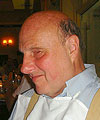Thursday, January 27th
|

|
Tools and Techniques for
Individuals with Visual Impairments
William A. Gerrey, BSEE
Rehabilitation Engineering Center, Smith-Kettlewell Eye Research
Institute |
Abstract: A good problem statement
often leads to simple devices and alternate procedures that require very little
adaptations. A set of tools and instruments serving the job-related and
daily-living activities of individuals with vision impairments will be
displayed and described including techniques for electronic and mechanical
measurement.
Biosketch: Bill Gerrey has worked as
an electrical engineer at the Rehabilitation Engineering Center of the
Smith-Kettlewell Eye Research Institute in San Francisco for over 35 years
where he designs vocational assistive devices, including measuring instruments
and devices relating to job modification.
Bill was born in Reno, NV in 1947 and has
been totally blind since a very early age. His interest in devices for the
blind goes back to his early childhood. His father, who was also blind, kindled
his passions for radio and early recording machines. His father's collection of
The Braille Technical Press which dates back to 1950 became an integral
part of Bill's education. With the encouragement of Robert W. Gunderson, the
editor of the magazine, the Technical File, a publication of technical
information for blind enthusiasts, was born and continues to be supported by
Smith-Kettlewell.
He got his amateur radio license (WA6NPC) in
1960 as a teenager and now holds an Extra Class license.
Bill earned a Bachelor's degree in
Electronics Engineering from California State Polytechnic College in San Luis
Obispo in 1971. His many activities
include:
- founder and editor of the
Smith-Kettlewell Technical File (an international magazine for the
blind)
- lecturer at state rehabilitation technical
seminars
- exhibitor at the annual RESNA conferences
and the Lawerence Hall of Science Career Program
- field instructor for the Sensory Aids
Foundation
- participant on the Handicapped Scientists
Panel at the AAAS Annual Conference
- expert witness before the California State
Attorney General's Commission on Disability
- teacher of classes on electricity and
magnetism at the Lawton Elementary School in San Francisco
- panelist at the Arizona Governor's
Committee on Employment of the Blind
- instructor of Exploring the Mysteries
of Creativity workshop sponsored by the San Francisco Unified School
District Center for the Advancement and Renewal of Educators
- member of the NIDRR / GSA Task Force on
Accessibility Guideleines for Electronic Equipment
- member of the Advisory Committee for
Computer and Customer Service Training Program of the Lions Blind Center in
Oakland
Bill is a member of many professional
organizations including IEEE, RESNA, AAAS, and NFB.
Bill's other interests include piano
restoration and collecting cylinder and other old recordings. He lives in San
Francisco with his wife.
- Contact information:
- The Rehabilitation Engineering Research
Center
- The Smith-Kettlewell Eye Research
Institute
- 2318 Filmore St.
- San Francisco,
CA 94115
- 415/345-2124
- Lecture Material:
- Pre-lecture
slides - 634 Kb pdf file
- Audio -
1:22:55 - 18.7 Mb mp3 file
- Handouts:
- Independent Living Aids
Catalog
- The Seven
Cycles of Braille
- Rehabilitation
Engineering - Small Scale with Impact
- Support
Services and Principles of Adapting to Vision Loss
- Infant
Patting Device
- Development and Evaluation of a Thoracic
Pressure Chair For a Student with Autism
- Paper discussing a
therapeutic thoracic pressure chair (TPC) developed for a 13-year-old male
student with autism. The components of the chair consist of a motor that
rotates a set of two pulleys. A single length of aircraft wire is connected to
the two ends of a pressure platform and pulley. When the motor is activated,
the pulley system is rotated. The pressure platform then rises along four guide
rods and moves towards the user’s chest. With the aid of a gas spring, the
platform is guided away from the user’s chest, and the door opens at its
starting position. After a six-month follow up, the teachers reported that the
student used the chair at least once a day.
- Links:
- Bill Gerrey
-
Smith-Kettlewell Technical Files
- Leading the
Blind
- Josh
Miele's blog entry about Bill
- Talking Signs
- Smith-Kettlewell Display
Tools
- Devices Supportive of
Research
- LS&S Group
|
